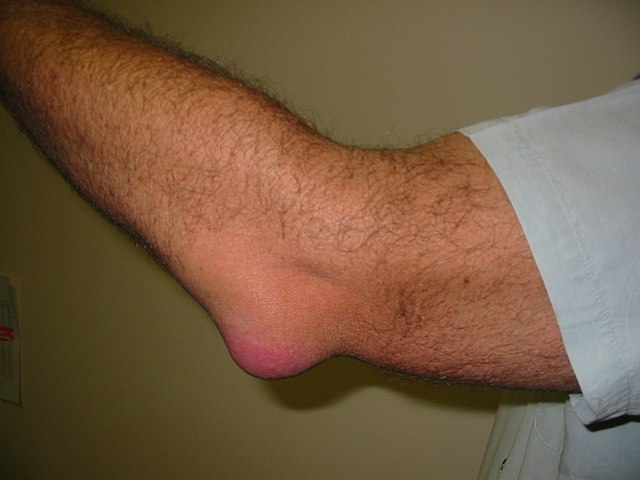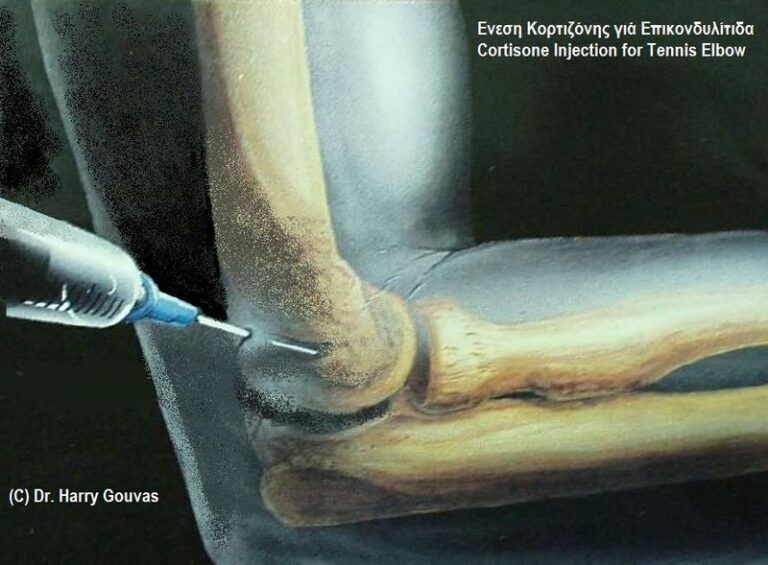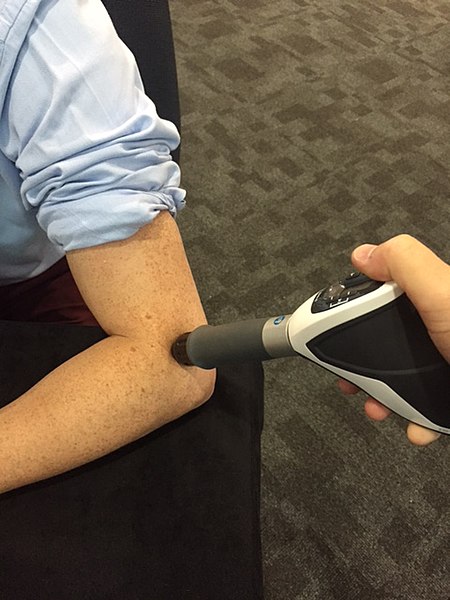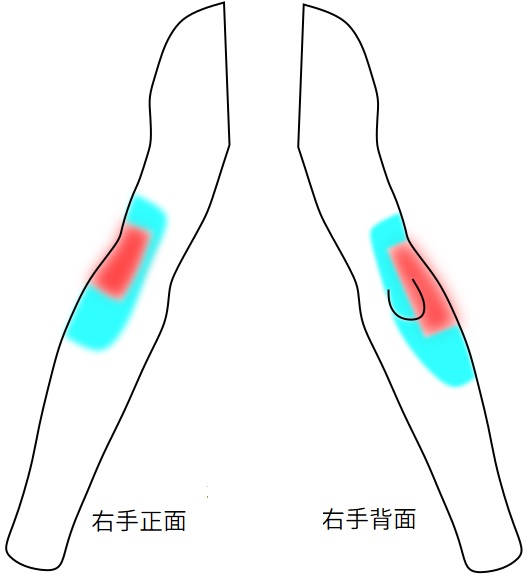摘要
網球肘的正式病名為肱骨外上髁炎。長期過度使用或不當姿勢使用肘關節,造成肘部外側痛,就可能被醫師診斷為網球肘。然而,研究證據顯示網球肘不是局部發炎、不是肌腱炎,所以各種治療效果都不好。無論是物理治療、類固醇注射、PRP、體外震波治療,許多國際論文顯示療效沒有比不治療更好。反而是按摩被證明比各種治療有效。因為網球肘不是病,只是疲勞緊繃痠痛,所以該做的是適當休息、保持適當活動、以及按摩放鬆手肘部位疲勞緊繃的軟組織。
引用本文:
李侑青,”網球肘的治療與手肘緊繃痠痛的按摩處理”,Dr. 李侑青的樂活養生教室,2021年8月24日,https://drleeclass.com/2021/08/tennis-elbow/。
大綱
網球肘的症狀與診斷方式
網球肘 (tennis elbow) 的醫學病名為肱骨外上髁炎 (lateral epicondylitis),屬於手肘關節外側部位的肌腱炎 (tendinitis),如置頂圖所示 [1]。網球肘的盛行率約在 1~3% 之間 [2]。網球肘的手臂提重物或做動作時,手肘外側疼痛,並且手部抓握力量降低,嚴重時連筆都握不住。如果疼痛的部位在手肘內側,則是高爾夫球肘 (golfer’s elbow),正式病名為肱骨內上髁炎 (medial epicondylitis)。手肘外側部位的疼痛不一定是網球肘,也可能是韌帶受傷發炎、軟骨損傷發炎或關節變形造成神經壓迫。受傷、感染,以及組織病變如腫瘤、癌化等,都可能產生手肘發炎症狀。組織發炎的典型症狀為紅腫熱痛,如圖一所示。

臨床上,醫師要先排除前述的幾種手肘受傷或疾病的可能性,之後才會確診網球肘。醫師會先測試是否前臂外旋及手腕伸直時肘部外側痛,接著詢問是否有重覆用力動作或不當使用肘關節的情節,若長期過度使用又缺乏適當的休息,符合以上情節者就可能被醫師診斷為網球肘。
有許多客人來找我解決網球肘的問題。我問他們,為何醫生可以確診你是肱骨外上髁炎 (網球肘的正式病名)?臨床上,這些被確診為肱骨外上髁炎的患者,手肘外觀並沒有紅腫熱的發炎症狀,也沒有出血瘀斑等組織受傷的症狀。我再問他們,醫生有沒有局部抽血或切片採樣組織,由血液檢查發炎物質或由病理切片檢查發炎細胞?結果往往都回答沒有。這讓我們對醫生的診斷產生懷疑。
2016 年的影像醫學研究,分析比對了 369 位非網球肘患者的磁共振造影 (Magnetic Resonance Imaging, MRI),在非患者個體中可以看到與患者一致的 MRI 徵象,這表明網球肘不是局部發炎 [3]。在手術過程採集的標本中,發現網球肘的組織切片缺乏發炎特徵,因此,網球肘並非肌腱炎 [4]。2020 年國際科學性肌腱病變討論會更直接建議,如果肘外側肌腱確實有生病或受傷,就直接稱為肘外側肌腱病變 (lateral elbow tendinopathy) [5]。
因此,你的手肘不舒服,假如沒有紅腫熱發炎症狀,也無外傷,只是過度使用就被診斷為網球肘的話,你要懷疑這是醫生在推銷疾病、推銷醫療產品,而非基於科學證據的循證醫學確診。

為何網球肘一直治不好
網球肘一般的治療有效的話,也要三個月之內才會好轉 [6]。這顯示醫療行為治療網球肘的效果不良。為何網球肘會一直治不好呢?先從目前骨科、復健科、物理治療的醫療效果說起。
被醫師確診為網球肘的患者,可能被推薦幾種醫療產品,如電療、超音波、雷射刺激、徒手治療等等物理治療,消炎藥、止痛藥、類固醇注射 (如圖三所示 [7]) 等藥物治療,一次數千元的體外衝擊波治療,一次數千到上萬元的自體高濃度血小板血漿 (platelet-rich plasma, PRP) 注射治療,以及肉毒桿菌毒素治療。這些醫療行為有各種不同的醫療效果,如促進血液循環、降低發炎、止痛、加速癒合等等。
假如網球肘是疾病、受傷,那麼醫療行為肯定能產生療效。實際效果如何呢?讓我們來看看國際上的研究報告。過去的研究已顯示雷射刺激治療與安慰劑處理的結果,沒有差異 [8-10]。近年的研究顯示,物理治療並沒有效果,衝擊波、雷射刺激、神經電刺激、超音波或脈衝磁波療法,對於網球肘都欠缺顯著的效益 [11-13]。對於注射治療,在使用類固醇注射半年後的結果,不如鹽水注射,甚至不治療都更好 [14]。比較類固醇、物理治療,類固醇注射短期似乎可止痛,但長期效果不如不治療,甚至惡化,並且類固醇治療組和物理治療組治療 1 年的結果並不比僅用消炎止痛藥的觀望組更好 [15-18]。2019 年的研究報告更直接表明,衝擊波、雷射刺激、電療、超音波或脈衝電磁波療法均未證明任何益處,並且總是不該使用類固醇注射治療網球肘 [19]。

自費的醫療每次要價數千到數萬元,例如 PRP 注射治療、體外衝擊波治療、肉毒桿菌毒素治療,對網球肘的療效有比較好嗎?無論是 1 個月或 3 個月的 PRP 注射治療,其效果都沒有優於類固醇注射的表現 [20]。體外衝擊波療法 (如圖四所示 [21]) 宣稱可以促進組織癒合,並可能通過刺激神經纖維產生鎮痛作用來減輕疼痛。然而,多項研究結果卻沒有發現治療組和安慰劑組之間有任何實質性差異 [22-26]。肉毒桿菌毒素治療的爭議更大,應該被放棄作為網球肘的治療方法,因為它只有短暫的效果,卻幾乎總是有肌肉伸展無力的副作用 [27-29]。
綜合評估比較各種治療的實驗,也都顯示醫療行為無助於網球肘。以超音波檢查來比較物理治療方式(熱敷、超音波治療和徒手按摩)、局部類固醇注射和體外衝擊波治療在網球肘的治療效果,結果在任何組的隨訪期間,超聲檢查都沒有顯示出改變 [30]。整體來說,沒有證據表明非手術的治療比不治療更好 [31]。甚至,非醫療的運動貼附都比體外衝擊波治療還有效 [32]。
所以,各位如果被醫生診斷為網球肘,且治療效果不顯著或緩慢的話,請勿覺得灰心,種種事實已經告訴你,醫療行為對網球肘無效。為什麼會無效呢?因為網球肘不是病,而是健康的手肘疲勞緊繃的正常痠痛現象而已。醫療行為當然無法治療本來就是健康的手肘。如果有任何醫師宣稱你罹患網球肘 (肱骨外上髁炎) 要對你施以醫療行為治療,你要懷疑那是不當推銷醫療產品。

運用按摩解決手肘痠痛問題
網球肘不是疾病或受傷,網球肘的真相就是手肘部位的軟組織因為施力不當或過勞導致累積疲勞,造成局部軟組織緊繃,因疲勞緊繃而引發痠痛不適感。預防網球肘,平時就需注意工作或運動的姿勢,長時間連續使用之間需適度休息,切勿過度疲勞。萬一過勞導致軟組織緊繃的話,除了休息恢復,還可以使用按摩來幫助放鬆軟組織。最近的研究比較了按摩與物理治療、類固醇注射治療在網球肘的療效,在半年的隨訪中,只有按摩組的患者在所有結果指標上都表現出顯著改善,這些參數在物理治療組中沒有改善 [33]。
我處理過許多打桌球、打網球、打羽球、各種職業工人,他們被醫師診斷為網球肘來治療,被醫師或物理治療師治療數個月,結果手肘依舊用力就痛、某個姿勢就痛、或某些動作就痠軟無法用力。我能讓他們的手肘恢復正常,原因在於他們的手肘本來就是健康沒有生病或受傷的,只是疲勞緊繃,所以醫療行為只是花費昂貴又浪費醫療資源,而我幫他們按摩,放鬆手肘周圍相關的軟組織,解決疲勞緊繃之後,痠痛無力不舒服等問題就消失了。手肘外側疲勞緊繃痠痛的按摩位置如圖五所示。
疲勞緊繃痠痛與受傷發炎疼痛不同。疼痛是組織損傷的反應,比如蜂窩性組織炎或刀傷燙傷的傷口,會一直疼痛。但是疲勞緊繃痠痛不會一直痠痛,只有在改變姿勢、用力、或局部壓迫時,才會產生不舒服的感覺。因此,如果客人的不舒服是 24 小時都痛,那我就會請他們去找醫師治療疾病。反之,因為他們的不舒服是痠痛,都是他們用力了才不舒服,或者我按摩壓了他們的手肘才不舒服,所以我就確定客人的手肘不舒服困擾原因是痠痛。按摩可以有效放鬆軟組織的疲勞緊繃,解決痠痛的問題。所以,因為手肘不舒服被醫師診斷為網球肘且好久都治不好而被推薦來找我的客人,我來一個解決一個,輕鬆無比。不是按摩具有療效能治療網球肘,而是網球肘根本就不是病,只是疲勞緊繃,所以花大錢的各種醫療都對健康的手肘無效,但按摩能有效放鬆疲勞緊繃的手肘,所以解決手肘的不舒服問題,如此而已。
如果沒有紅腫熱等發炎症狀,你的手肘外側不舒服就不是網球肘 (肱骨外上髁炎),手肘內側不舒服就不是高爾夫球肘 (肱骨內上髁炎),而是單純的手肘部位軟組織疲勞緊繃痠痛。你該做的不是去醫院診所,這只會害醫生浪費寶貴搶救生命重傷害的時間在健康的你身上,請勿浪費醫療資源、害醫院診所耽誤其他病人傷患的時間。你該做的是適當休息、保持適當活動、以及按摩放鬆手肘部位疲勞緊繃的軟組織。

即時獲取本站最新消息與 Dr. 李侑青交流互動,請按讚追蹤粉絲頁喔 ➝
參考文獻
[1] 置頂圖,來自 Elbow pain,作者為 Injurymap,依 CC BY 4.0 授權使用。
[2] 健康醫療網,https://www.healthnews.com.tw/news/article/50801
[3] W. F. Van Leeuwen, S. J. Janssen, D. Ring, N. Chen, “Incidental magnetic resonance imaging signal changes in the extensor carpi radialis brevis origin are more common with age,” Journal of Shoulder and Elbow Surgery, vol. 25, pp. 1175-1181, 2016.
[4] B. S. Kraushaar, R. P. Nirschl, “”Tendinosis of the elbow (tennis elbow). Clinical features and findings of histological, immunohistochemical, and electron microscopy studies,” The Journal of Bone and Joint Surgery, vol. 81, pp. 259-278, 1999.
[5] A. Scott, K. Squier, H. Alfredson, et al, “ICON 2019: International Scientific Tendinopathy Symposium Consensus: Clinical Terminology,” British Journal of Sports Medicine, vol.54, pp. 260-262, 2020.
[6] 元氣網,https://health.udn.com/health/story/5967/3756454
[7] 圖三,來自 Ενεση Κορτιζόνης σε Επικονδυλίτιδα,作者為 Harrygouvas,依 CC BY-SA 3.0 授權使用。
[8] E. Haker, T. Lundeberg, “Laser treatment applied to acupuncture points in lateral humeral epicondylalgia. A double-blind study,” Pain, vol. 43(2), pp. 243–247, 1990.
[9] M. Krasheninnikoff, N. Ellitsgaard, B. Rogvi-Hansen, et al., “No effect of low power laser in lateral epicondylitis,” Scandi Journal of Rheumatology, vol. 23(5), pp. 260–263, 1994.
[10] E. S. Papadopoulos, R. W. Smith, M. I. D. Cawley, et al., “Low-level laser therapy does not aid the management of tennis elbow,” Clinical Rehabilitation, vol. 10, pp. 9–11, 1996.
[11] L. Bisset, A. Paungmali, B. Vicenzino, E. Beller, “A systematic review and meta-analysis of clinical trials on physical interventions for lateral epicondylalgia,” British Journal of Sports Medicine, vol. 39, pp. 411-422, 2005.
[12] C. Weber, V. Thai, K. Neuheuser, K. Groover, O. Christ, “Efficacy of physical therapy for the treatment of lateral epicondylitis: a meta-analysis,” BMC Musculoskeletal Disorders, vol. 16, pp. 223, 2015.
[13] S. Dion, J.J. Wong, P. Côté, H. Yu, D. Sutton, K. Randhawa, et al., “Are passive physical modalities effective for the management of common soft tissue injuries of the elbow?.: A systematic review by the Ontario Protocol for Traffic Injury Management (OPTIMa) Collaboration,” The Clinical Journal of Pain, vol. 33, pp. 71-86, 2017.
[14] M. Olaussen, Ø. Holmedal, I. Mdala, S. Brage, M. Lindbæk, “Corticosteroid or placebo injection combined with deep transverse friction massage. Mills manipulation, stretching and eccentric exercise for acute lateral epicondylitis: a randomised, controlled trial,” BMC Musculoskeletal Disorders, vol. 16, pp. 122, 2015.
[15] L. Bisset, E. Beller, G. Jull, P. Brooks, R. Darnell, B. Vicenzino, “Mobilisation with movement and exercise, corticosteroid injection, or wait and see for tennis elbow: randomised trial,” British Medical Journal, vol. 333, pp. 939, 2006.
[16] L. Bisset, N. Smidt, D. A. Van der Windt, et al. “Conservative treatments for tennis elbow do subgroups of patients respond differently?” Rheumatology, vol. 46(10), pp. 1601–1605, 2007.
[17] B. K. Coombes, L. Bisset, P. Brooks, et al., “Effect of corticosteroid injection, physiotherapy, or both on clinical outcomes in patients with unilateral lateral epicondylalgia: a randomized controlled trial,” The Journal of the American Medical Association, vol. 309(5), pp. 461–469, 2013.
[18] N. Smidt, D. A. van der Windt, W. J. Assendelft, et al., “Corticosteroid injections, physiotherapy, or a wait-and-see policy for lateral epicondylitis: a randomised controlled trial,” Lancet, vol. 359(9307), pp. 657–662, 2002.
[19] H. Lenoir, et al., “Management of lateral epicondylitis.” Orthopaedics & traumatology, surgery & research, vol. 105(8S), pp. S241-S246, 2019.
[20] T. P. Krogh, U. Fredberg, K. Stengaard-Pedersen, et al., “Treatment of lateral epicondylitis with platelet-rich plasma, glucocorticoid, or saline: a randomized, double-blind, placebo-controlled trial,” The American Journal of Sports Medicine, vol. 41(3), pp. 625–635, 2013.
[21] 圖四,來自 Delivering a treatment,作者為 Jpwvenn,依 CC BY-SA 3.0 授權使用。
[22] B. Chung, J. P. Wiley, M. S. Rose, “Long-term effectiveness of extracorporeal shockwave therapy in the treatment of previously untreated lateral epicondylitis,” Clinical Journal of Sport Medicine, vol. 15(5), 305–312, 2005.
[23] E. Haker, T. Lundeberg, “Laser treatment applied to acupuncture points in lateral humeral epicondylalgia. A double-blind study,” Pain, vol. 43(2), pp. 243–247, 1990.
[24] E. Y. Melikyan, E. Shahin, J. Miles, et al., “Extracorporeal shock-wave treatment for tennis elbow. A randomised double-blind study,” The Journal of Bone and Joint Surgery. British volume, vol. 85(6), pp. 852–855, 2003.
[25] C. A. Speed, D. Nichols, C. Richards, et al., “Extracorporeal shock wave therapy for lateral epicondylitis—a double blind randomised controlled trial,” Journal of Orthopaedic Research, vol. 20(5), pp. 895–898, 2002.
[26] M. P. Staples, A. Forbes, R. Ptasznik, et al., “A randomized controlled trial of extracorporeal shock wave therapy for lateral epicondylitis (tennis elbow),” The Journal of Rheumatology, vol. 35(10), pp. 2038–2046, 2008.
[27] R. Espandar, P. Heidari, M.R. Rasouli, S. Saadat, M. Farzan, M. Rostami, et al., “Use of anatomic measurement to guide injection of botulinum toxin for the management of chronic lateral epicondylitis: a randomized controlled trial,” Canadian Medical Association Journal, vol. 182, pp. 768-773, 2010.
[28] M.J. Hayton, A.J. Santini, P.J. Hughes, S.P. Frostick, I.A. Trail, J.K. Stanley, “Botulinum toxin injection in the treatment of tennis elbow. A double-blind, randomized, controlled, pilot study,” The Journal of bone and joint surgery. American volume, vol. 87, pp. 503-507, 2005.
[29] Y.C. Lin, W.T. Wu, Y.C. Hsu, D.S. Han, K.V. Chang, “Comparative effectiveness of botulinum toxin versus non-surgical treatments for treating lateral epicondylitis: a systematic review and meta-analysis,” Clinical Rehabilitation, vol. 32, pp. 131-145, 2018.
[30] R. Gündüz, et al., “Physical therapy, corticosteroid injection, and extracorporeal shock wave treatment in lateral epicondylitis. Clinical and ultrasonographical comparison.” Clinical Rehabilitation, vol. 31(5), pp. 807-812, 2012.
[31] E.T. Sayegh, R.J. Strauch, “Does nonsurgical treatment improve longitudinal outcomes of lateral epicondylitis over no treatment? A meta-analysis,” Clinical Orthopaedics and Related Research, vol. 473, pp. 1093-1107, 2015.
[32] T. Guler, P. Yildirim, “Comparison of the efficacy of kinesiotaping and extracorporeal shock wave therapy in patients with newly diagnosed lateral epicondylitis: A prospective randomized trial,” Nigerian Journal of Clinical Practice, vol. 23(5), pp. 704-710, 2020.
[33] R. Yi, et al., “Deep Friction Massage Versus Steroid Injection in the Treatment of Lateral Epicondylitis,” Hand (New York, N.Y.), vol. 13(1), pp. 56-59, 2018.
